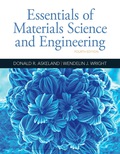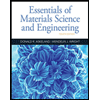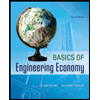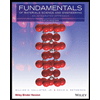
(a)
Interpretation:
The expected coordination number for Y2O3 compound is determined using the ionic radii in given B appendix.
Concept Introduction:
The Y2O3 is the yttrium oxide which is stable in the atmosphere and is a white substance that is in the solid form. In inorganic compounds and science the yttrium oxide is used as the starting material. Here, in the compound, cation is Y3+ and anion is O2− thus, according to the formula there will be 2 cations and 3 anions. The ratio of radius of cation to anion can helps in determining the coordination number of the compound from table B in Appendix
Answer to Problem 3.85P
6 is the coordination number.
Explanation of Solution
For the selected elements the radii of atoms and ions from the table are given as,
rY+3=0.890ArO−2=1.320A
The ratio of the radius is given as,
rY+3rO−2=0.890A1.320A⇒0.67
From the table the coordination number of Y2O3 is given as 6
(b)
Interpretation:
The expected coordination number for UO2 compound is determined using the ionic radii in given B appendix.
Concept Introduction:
Uranium dioxide also called as Urania is black in color. This element is radioactive and powdered crystalline and it is found in the uraninite mineral. From the formula, UO2the cation is U4+ and anion is O2−. The number of cations is 1 and that of anion is 2. The ratio of radius of cation to anion can helps in determining the coordination number of the compound from table B in Appendix
Answer to Problem 3.85P
6 is the coordination number.
Explanation of Solution
For the selected elements the radii of atoms and ions from the table are given as,
rU+4=0.970ArO−2=1.320A
The ratio of the radius is given as,
rU+4rO−2=0.970A1.320A⇒0.73
From the table the coordination number of UO2is given as 6
(c)
Interpretation:
The expected coordination number for BaO compound is determined using the ionic radii in given B appendix.
Concept Introduction:
The compound Barium oxide is non-flammable. It is white in color and the structure of the compound is cube. It is used in the crown glass, cathode ray tubes and catalyst. From the formula there will be 1 cation that is Ba2+ and 1 anion that is O2−. The ratio of radius of cation to anion can helps in determining the coordination number of the compound from table B in Appendix.
Answer to Problem 3.85P
8 is the coordination number.
Explanation of Solution
For the selected elements the radii of atoms and ions from the table are given as,
rBa+2=1.340ArO−2=1.320A
The ratio of the radius is given as,
rBa+2rO−2=1.340A1.320A⇒0.99
From the table the coordination number of BaO is given as 8
(d)
Interpretation:
The expected coordination number for Si3N4 compound is determined using the ionic radii in given B appendix.
Concept Introduction:
The compound silicon nitride is a compound that is made of nitrogen and silicon. This chemical compound is stable
Answer to Problem 3.85P
4 is the coordination number.
Explanation of Solution
For the selected elements the radii of atoms and ions from the table are given as,
rN−3=0.150ArSi+4=0.420A
The ratio of the radius is given as,
rN−3rSi+4=0.150A0.420A⇒0.36
From the table the coordination number of Si3N4 is given as 4
(e)
Interpretation:
The expected coordination number for GeO2 compound is determined using the ionic radii in given B appendix.
Concept Introduction:
GeO2 Compound is also called as germanium oxide which is the germanium salt. This compound is inorganic and it is main source for commercial. With contact of pure germanium the compound forms layer of passivation. From the formula of the compound, the anion and cation will be O2− and Ge4+ respectively. The ratio of radius of cation to anion can helps in determining the coordination number of the compound from table B in Appendix
Answer to Problem 3.85P
4 is the coordination number.
Explanation of Solution
For the selected elements the radii of atoms and ions from the table are given as,
rGe+4=0.530ArO−2=1.320A
The ratio of the radius is given as,
rGe+4rO−2=0.530A1.320A⇒0.40
From the table the coordination number of GeO2 is given as 4
(f)
Interpretation:
The expected coordination number for MnO compound is determined using the ionic radii in given B appendix.
Concept Introduction:
The MnO compound is inorganic and green crystals are formed by them. It acts as the food additives and fertilizer on a large scale. From the formula, the cation and anion will be Mn2+ and O2−.
The ratio of radius of cation to anion can helps in determining the coordination number of the compound from table B in Appendix
Answer to Problem 3.85P
6 is the coordination number.
Explanation of Solution
For the selected elements the radii of atoms and ions from the table are given as,
rMn+2=0.800ArO−2=1.320A
The ratio of the radius is given as,
rMn+2rO−2=0.800A1.320A⇒0.61
From the table B in Appendix, the coordination number of MnO is given as 6
(g)
Interpretation:
The expected coordination number for MgS compound is determined using the ionic radii in given B appendix.
Concept Introduction:
The MgS compound is inorganic and white in color. It accumulates in the impure form and it is made of crystalline material. In the impure form it is in the brown color and the material becomes non crystalline powder. From the formula, the cation is Mg2+ and anion is S−. The ratio of radius of cation to anion can helps in determining the coordination number of the compound from table B in Appendix
Answer to Problem 3.85P
6 is the coordination number.
Explanation of Solution
For the selected elements the radii of atoms and ions from the table are given as,
rMg+2=0.660ArS−2=1.320A
The ratio of the radius is given as,
rMg+2rS−2=0.660A1.320A⇒0.50
From the table the coordination number of MgS is given as 6
(h)
Interpretation:
The expected coordination number for KBr compound is determined using the ionic radii in given B appendix.
Concept Introduction:
Potassium bromide is the salt of ions and in the aqueous solution has pH 7 where it is completely dissociated. This compound is the bromide ions source. From the formula, the cation is K+ and anion is Br−. The ratio of radius of cation to anion can helps in determining the coordination number of the compound from table B in Appendix.
Answer to Problem 3.85P
6 is the coordination number.
Explanation of Solution
For the selected elements the radii of atoms and ions from the table are given as,
rK+1=1.330ArBr−1=1.960A
The ratio of the radius is given as,
rK+1rBr−1=1.330A1.960A⇒0.68
From the table the coordination number of KBr is given as 6
Want to see more full solutions like this?
Chapter 3 Solutions
Essentials Of Materials Science And Engineering
- 1. The figure shows a car jack to support 400kg (W=400kg). In the drawing, the angle (0) varies between 15 and 70 °. The links are machined from AISI 1020 hot-rolled steel bars with a minimum yield strength of 380MPa. Each link consists of two bars, one on each side of the central bearings. The bars are 300mm in length (/) and 25 mm in width (w). The pinned ends have the buckling constant (C) of 1.4 for out of plane buckling. The design factor (nd) is 2.5. (1) Find the thickness (t) of the bars and the factor of safety (n). (2) Check if the bar is an Euler beam. Darrow_forwardcan you do specific control loop for dc including reboiler and condenserarrow_forward- A 3-phase, 4-wire distributor supplies a balanced voltage of 400/230 V to a load consisting of 8 A at p.f. 0.7 lagging for R-phase, 10 A at p.f. 0-8 leading for Y phase and 12 A at unity p.f. for B phase. The resistance of each line conductor is 0.4 2. The reactance of neutral is 0.2 2. Calculate the neutral current, the supply voltage for R phase and draw the phasor diagram. The phase sequence is RYB.arrow_forward
- No AI WILL REJECTarrow_forwardCan you please do with hand calcs and answer the following: a Determine the global stiffness matrix (K) of the beam including indicating correct degrees-of freedom (dof) b i) Calculate vectors D and Q ii) Show partition and solve KD=Q for D iii) Calculate all reactions c BMD & max BM, deflected shape d i) Solve the problem using Strand7 (model) ii) Display the deflected shape and BMD e Comparisons of reactions + Max BM including commentsarrow_forward(Read image)arrow_forward
- I want to solve 13.2 using matlab please helparrow_forwarda) Show a possible trace of the OSPF algorithm for computing the routing table in Router 2 forthis network.b) Show the messages used by RIP to compute routing tables.arrow_forwardUNIVERSIDAD NACIONAL DE SAN ANTONIO ABAD DEL CUSCO PRIMER EXAMEN PARCIAL DE MECÁNICA DE FLUIDOS I ............ Cusco, 23 de setiembre de 2024 AP. Y NOMBRES: ........ 1.- Para el tanque de la figura: a) Calcule la profundidad de la hidrolina si la profundidad del agua es de 2.8 m y el medidor del fondo del tanque da una lectura de 52.3kPa. b) Calcule la profundidad del agua si la profundidad de la hidrolina es 6.90 m y el medidor de la parte inferior del tanque registra una lectura de 125.3 kPa. Hidrolina Sp=0.90 Abertura Agua sup suge to but amulor quit y 2.- Calcule la magnitud de la fuerza resultante sobre el área A-B y la ubicación del centro de presión. Señale la fuerza resultante sobre el área y dimensione su ubicación con claridad. 3.5 ft 12 in: Oil (38-0.93) 14 in 8 inarrow_forward
- using r language to answer question 4 Question 4: Obtain a 95% standard normal bootstrap confidence interval, a 95% basic bootstrap confidence interval, and a percentile confidence interval for the ρb12 in Question 3.arrow_forwardplease solve this problem and give me the correct answer step by steparrow_forwardplease solve this problem step by step and show the best way that can be explainedarrow_forward
 MATLAB: An Introduction with ApplicationsEngineeringISBN:9781119256830Author:Amos GilatPublisher:John Wiley & Sons Inc
MATLAB: An Introduction with ApplicationsEngineeringISBN:9781119256830Author:Amos GilatPublisher:John Wiley & Sons Inc Essentials Of Materials Science And EngineeringEngineeringISBN:9781337385497Author:WRIGHT, Wendelin J.Publisher:Cengage,
Essentials Of Materials Science And EngineeringEngineeringISBN:9781337385497Author:WRIGHT, Wendelin J.Publisher:Cengage, Industrial Motor ControlEngineeringISBN:9781133691808Author:Stephen HermanPublisher:Cengage Learning
Industrial Motor ControlEngineeringISBN:9781133691808Author:Stephen HermanPublisher:Cengage Learning Basics Of Engineering EconomyEngineeringISBN:9780073376356Author:Leland Blank, Anthony TarquinPublisher:MCGRAW-HILL HIGHER EDUCATION
Basics Of Engineering EconomyEngineeringISBN:9780073376356Author:Leland Blank, Anthony TarquinPublisher:MCGRAW-HILL HIGHER EDUCATION Structural Steel Design (6th Edition)EngineeringISBN:9780134589657Author:Jack C. McCormac, Stephen F. CsernakPublisher:PEARSON
Structural Steel Design (6th Edition)EngineeringISBN:9780134589657Author:Jack C. McCormac, Stephen F. CsernakPublisher:PEARSON Fundamentals of Materials Science and Engineering...EngineeringISBN:9781119175483Author:William D. Callister Jr., David G. RethwischPublisher:WILEY
Fundamentals of Materials Science and Engineering...EngineeringISBN:9781119175483Author:William D. Callister Jr., David G. RethwischPublisher:WILEY





